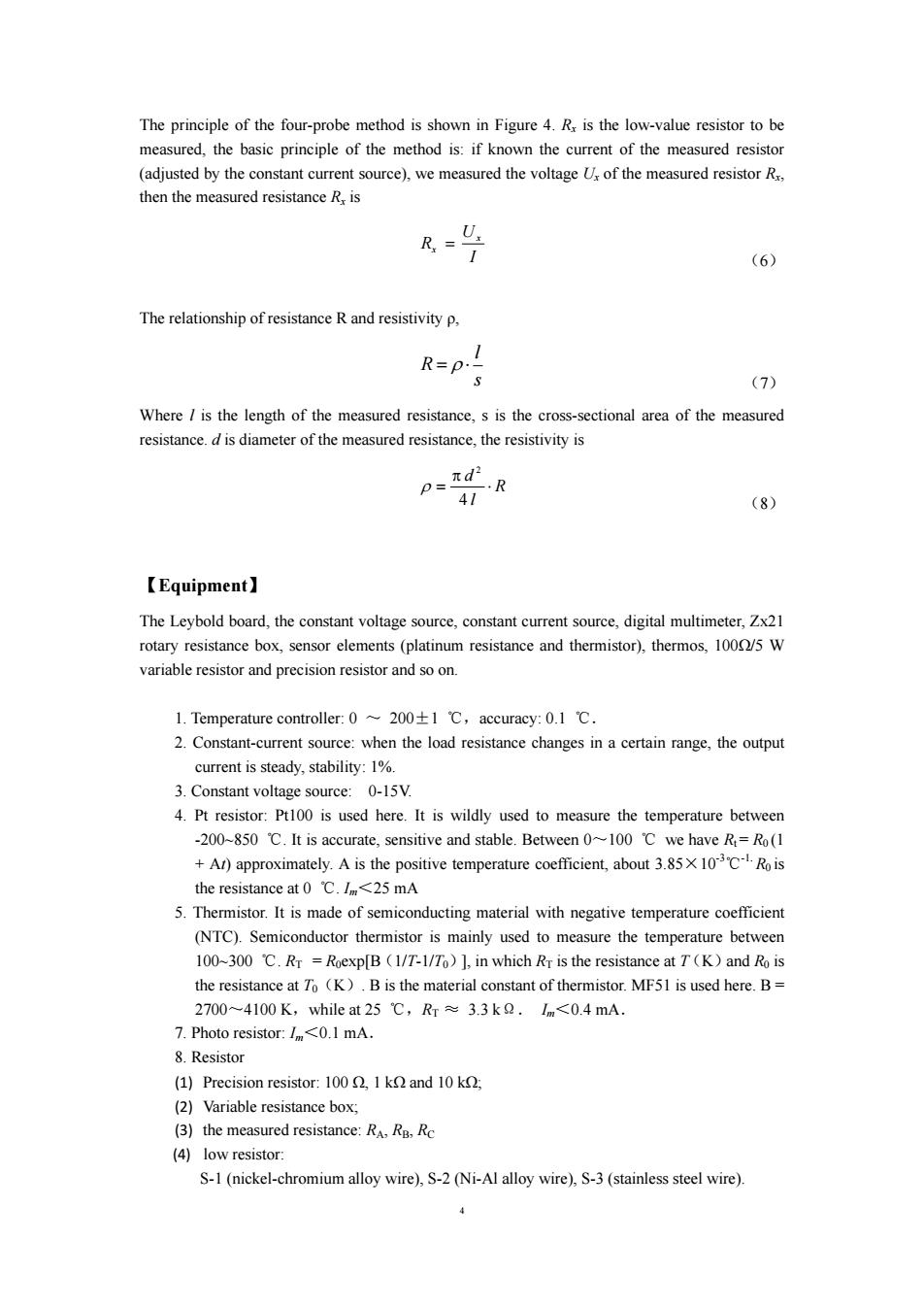正在加载图片...

The principle of the four-probe method is shown in Figure 4.Rx is the low-value resistor to be measured,the basic principle of the method is:if known the current of the measured resistor (adjusted by the constant current source),we measured the voltage U of the measured resistor R, then the measured resistance R,is R,= (6) The relationship of resistance R and resistivity p, R=P.- (7) Where is the length of the measured resistance,s is the cross-sectional area of the measured resistance.d is diameter of the measured resistance,the resistivity is psπd …R 41 (8) 【Equipment】. The Leybold board,the constant voltage source,constant current source,digital multimeter,Zx21 rotary resistance box,sensor elements(platinum resistance and thermistor),thermos,1000/5 W variable resistor and precision resistor and so on. 1.Temperature controller:0~200±1℃,accuracy:0.l℃. 2.Constant-current source:when the load resistance changes in a certain range,the output current is steady,stability:1%. 3.Constant voltage source:0-15V. 4.Pt resistor:Pt100 is used here.It is wildly used to measure the temperature between -200~850 C.It is accurate,sensitive and stable.Between 0~100 C we have R=Ro(1 +Ar)approximately.A is the positive temperature coefficient,about 3.85X10CRois the resistance at 0 C.Im<25 mA 5.Thermistor.It is made of semiconducting material with negative temperature coefficient (NTC).Semiconductor thermistor is mainly used to measure the temperature between 100~300 C.Rr =Roexp[B (1/T-1/To)],in which Rr is the resistance at T(K)and Ro is the resistance at To (K).B is the material constant of thermistor.MF51 is used here.B= 2700~4100K,while at25℃,Rr≈3.3k2.Im<0.4mA. 7.Photo resistor:I<0.1 mA. 8.Resistor (1)Precision resistor:100 1 k and 10 k; (2)Variable resistance box; (3)the measured resistance:RA,RB,Rc (4)low resistor: S-1(nickel-chromium alloy wire),S-2(Ni-Al alloy wire),S-3(stainless steel wire).4 The principle of the four-probe method is shown in Figure 4. Rx is the low-value resistor to be measured, the basic principle of the method is: if known the current of the measured resistor (adjusted by the constant current source), we measured the voltage Ux of the measured resistor Rx, then the measured resistance Rx is I U R x x = (6) The relationship of resistance R and resistivity ρ, R = ρ ⋅ l s (7) Where l is the length of the measured resistance, s is the cross-sectional area of the measured resistance. d is diameter of the measured resistance, the resistivity is R l d ⋅ π = 4 2 ρ (8) 【Equipment】 The Leybold board, the constant voltage source, constant current source, digital multimeter, Zx21 rotary resistance box, sensor elements (platinum resistance and thermistor), thermos, 100Ω/5 W variable resistor and precision resistor and so on. 1. Temperature controller: 0 ~ 200±1 ℃,accuracy: 0.1 ℃. 2. Constant-current source: when the load resistance changes in a certain range, the output current is steady, stability: 1%. 3. Constant voltage source: 0-15V. 4. Pt resistor: Pt100 is used here. It is wildly used to measure the temperature between -200~850 ℃. It is accurate, sensitive and stable. Between 0~100 ℃ we have Rt = R0 (1 + At) approximately. A is the positive temperature coefficient, about 3.85×10-3℃-1. R0 is the resistance at 0 ℃. Im<25 mA 5. Thermistor. It is made of semiconducting material with negative temperature coefficient (NTC). Semiconductor thermistor is mainly used to measure the temperature between 100~300 ℃. RT = R0exp[B(1/T-1/T0)], in which RT is the resistance at T(K)and R0 is the resistance at T0(K). B is the material constant of thermistor. MF51 is used here. B = 2700~4100 K,while at 25 ℃,RT ≈ 3.3 kΩ. Im<0.4 mA. 7. Photo resistor: Im<0.1 mA. 8. Resistor (1) Precision resistor: 100 Ω, 1 kΩ and 10 kΩ; (2) Variable resistance box; (3) the measured resistance: RA, RB, RC (4) low resistor: S-1 (nickel-chromium alloy wire), S-2 (Ni-Al alloy wire), S-3 (stainless steel wire)